
States where the economy has recovered the most from COVID-19
This story originally appeared on Credible and was produced and distributed in partnership with Stacker Studio.
States where the economy has recovered the most from COVID-19
While the full economic impact of the coronavirus can only be revealed in the months and years ahead, one thing is fairly likely: Rebuilding the nation will depend largely on how well America can continue to contain the spread of COVID-19. As of June 2021, nearly 50% of Americans have received at least one dose of the vaccine, which has allowed states and businesses to more fully reopen, increasing spending and revenue. But even as many states have returned to some semblance of normalcy, most statewide economies will need more time before they’ve returned to pre-pandemic levels.
The pace of economic recovery can take on many forms. For some economies, it will take on a V-shape, indicating a sharp decline and equally sharp recovery. Other will be K-shaped, meaning that certain sectors of the economy are recovering faster than others. States that depend on tourism, entertainment, and leisure as a crucial source of their economy are tending to recover more slowly, since those sectors have often been the hardest hit by the coronavirus in many states.
Credible analyzed economic data to create a weighted index that shows which states recovered the most from the coronavirus. To determine which state economies are recovering the most, Credible looked at four key metrics: change in unemployment rates, change in the number of jobs in the state, change in gross domestic product, and change in home values. Each metric and then the weighted average of all four metrics was graded on a 100-point scale, so an index score of 100 represents the highest economic recovery between 2020 and 2021.
April 2021 unemployment rates are from the U.S. Bureau of Labor Statistics. The House Price Index scores are from the Federal Housing Finance Agency, and measures housing price changes in single-family homes. Job growth statistics also come from the Bureau of Labor Statistics. The real GDP amounts for every state are from the U.S. Bureau of Economic Analysis. All statistics in this story are the most recent available as of June 10, 2021.
Read on to see which states have recovered the most, and the least, from the economic toll that the coronavirus has had on communities, industries, and local governments.

#51. Washington D.C.
- Index score: 0
- Unemployment rate in April 2021: 7.5% (3.6% less than in April 2020)
- House Price Index score in Q1 of 2021: 620.2 (10.2% greater than in 2020)
- Jobs existing in April 2021: 737,000 (2.2% greater than in April 2020)
- Real GDP in Q4 of 2020: $145.8 billion (current dollars, 5.7% greater than in Q2 of 2020)
In the U.S. capital, June 11, 2021 marked a turning point in the city’s fight against the coronavirus: It was the day that all capacity limits were eased and the city was 100% reopened. Specifically, bars, sporting arenas, and other entertainment venues were able to fully reopen for the first time since the pandemic, whereas capacity limits for schools, offices, museums, and other categories were lifted on May 21, 2021. And while the city’s cautiousness in reopening is likely correlating to the city’s low rate of COVID-19 transmission in addition to the high rate of vaccination, it was slower to ease restrictions than other nearby major cities like New York and nearby states like Virginia. Projections show that a full economic recovery is expected to happen in 2022.

#50. New Mexico
- Index score: 17.7
- Unemployment rate in April 2021: 8.2% (3.1% less than in April 2020)
- House Price Index score in Q1 of 2021: 298.5 (10.7% greater than in 2020)
- Jobs existing in April 2021: 790,200 (4.2% greater than in April 2020)
- Real GDP in Q4 of 2020: $102.6 billion (current dollars, 9.9% greater than in Q2 of 2020)
As of May 2021, the national unemployment rate was 5.5%, so New Mexico’s unemployment is higher than the national average. However, the state’s unemployment rate tends to be higher than the national average anyway. While New Mexico is making some strides toward the coronavirus recovery, the state is expected to recover more slowly, economically, than other states. Adding to this is the fact that New Mexico has kept up extended unemployment benefits for longer than many other states.
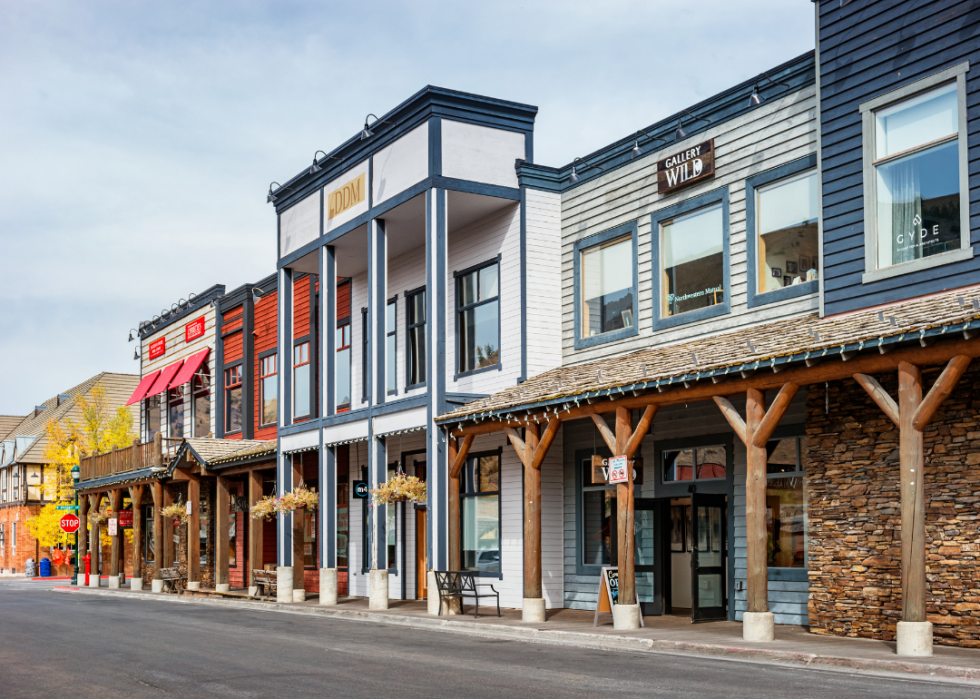
#49. Wyoming
- Index score: 18.8
- Unemployment rate in April 2021: 5.4% (3.8% less than in April 2020)
- House Price Index score in Q1 of 2021: 402.2 (7.5% greater than in 2020)
- Jobs existing in April 2021: 275,100 (4.7% greater than in April 2020)
- Real GDP in Q4 of 2020: $37.1 billion (current dollars, 11.5% greater than in Q2 of 2020)
Wyoming’s relatively slow recovery can be attributed, at least in part, to the loss of jobs in one of the state’s core job sectors: oil and gas. The state lost around 18,000 jobs by the end of 2021, and almost one third of those jobs lost were in the oil and gas industry. Moreover, the loss from those jobs trickled into losses in other related industries, such as transportation and manufacturing.
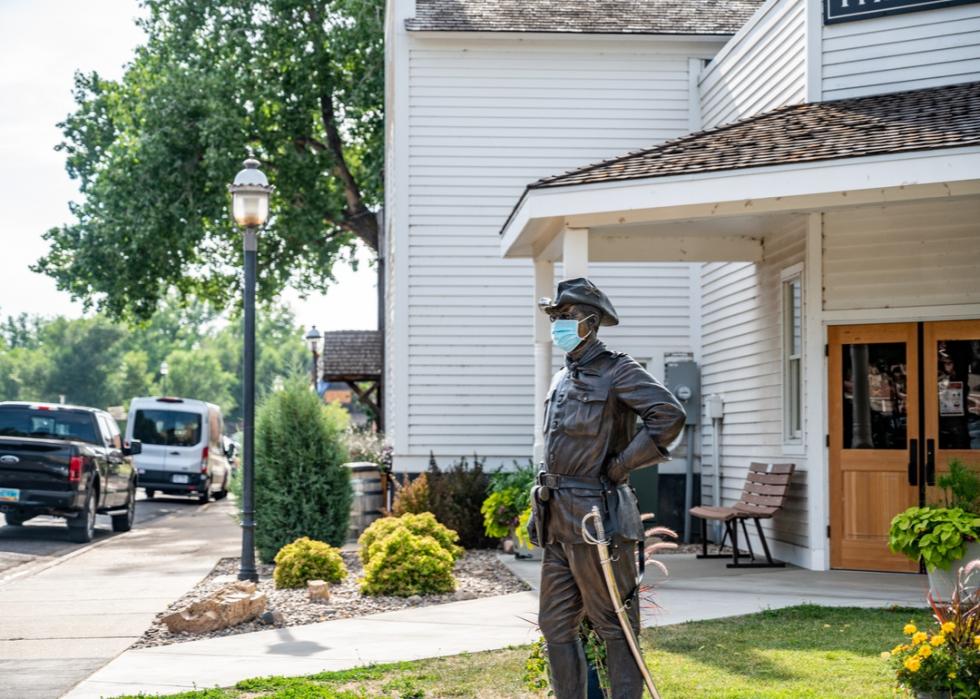
#48. North Dakota
- Index score: 25
- Unemployment rate in April 2021: 4.2% (4.3% less than in April 2020)
- House Price Index score in Q1 of 2021: 345.2 (5.9% greater than in 2020)
- Jobs existing in April 2021: 417,500 (8.2% greater than in April 2020)
- Real GDP in Q4 of 2020: $55.8 billion (current dollars, 11.8% greater than in Q2 of 2020)
There is some relatively good news in terms of the coronavirus recovery in North Dakota. Mainly, that GDP is increasing, the labor force is growing, and taxes are steadying. However, there are some concerns when it comes to the labor market, in that the unemployment rate is expected to be around 6.5% by the end of the fiscal year, with salaries and wages projected to decrease as well.
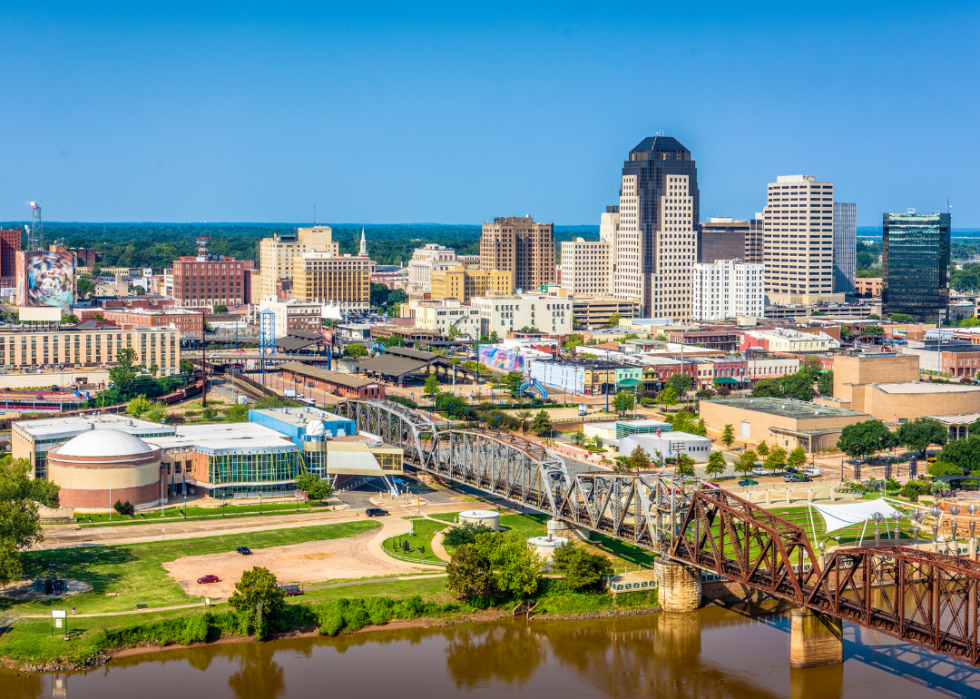
#47. Louisiana
- Index score: 25.7
- Unemployment rate in April 2021: 7.3% (7.2% less than in April 2020)
- House Price Index score in Q1 of 2021: 310 (5.4% greater than in 2020)
- Jobs existing in April 2021: 1,837,000 (7.5% greater than in April 2020)
- Real GDP in Q4 of 2020: $248.3 billion (current dollars, 10.8% greater than in Q2 of 2020)
When many think of Louisiana, the vibrant tourism industry—especially in New Orleans—comes to mind. Louisiana is the eighth most reliant state in the nation on tourism, and its struggle to recover in the wake of the coronavirus is in part a reflection of that. Of all workers in Louisiana, 10.5% are employed in the dining or hospitality industry, two industries that are ineluctably intertwined with tourism.

#46. Arkansas
- Index score: 29.2
- Unemployment rate in April 2021: 4.4% (5.8% less than in April 2020)
- House Price Index score in Q1 of 2021: 257.2 (8.8% greater than in 2020)
- Jobs existing in April 2021: 1,261,600 (8.3% greater than in April 2020)
- Real GDP in Q4 of 2020: $133 billion (current dollars, 10.1% greater than in Q2 of 2020)
Tourism and hospitality are the second-largest sources of revenue for the state, especially for its capital, Little Rock. Understandably, those industries took a hit as a result of the coronavirus, with many Americans reluctant to travel. On Feb. 11, 2021, the University of Arkansas at Little Rock received a $900,000 Coronavirus Aid, Relief, and Economic Security Act grant to aid with workforce training to help local industries and businesses recover from the economic fallout of the coronavirus.
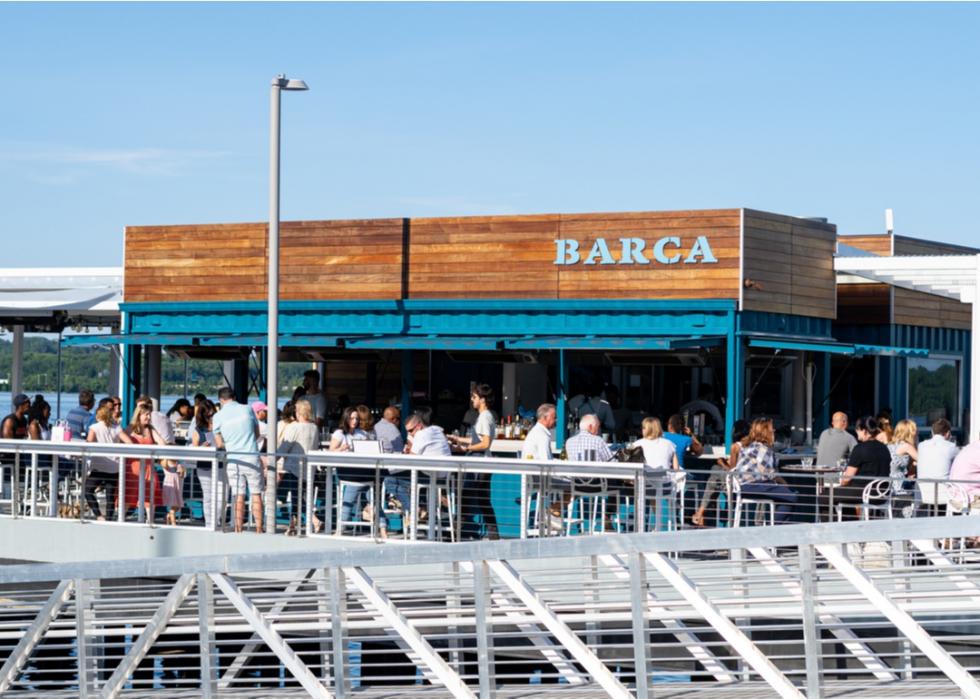
#45. Virginia
- Index score: 29.3
- Unemployment rate in April 2021: 4.7% (5.9% less than in April 2020)
- House Price Index score in Q1 of 2021: 309.5 (11.2% greater than in 2020)
- Jobs existing in April 2021: 3,889,700 (7.7% greater than in April 2020)
- Real GDP in Q4 of 2020: $566.4 billion (current dollars, 8.9% greater than in Q2 of 2020)
Rural counties in Virginia are thought to have a slower economic recovery than major metropolitan areas in 2021 and beyond. In part, this is because more rural areas are expected to struggle with attracting top remote workers to these areas. As of May 2021, Virginia has not yet initiated a job-creating tax credit for projects developed in these areas, but is working to attract more manufacturing and software development talent to rural Virginia.

#44. Iowa
- Index score: 30
- Unemployment rate in April 2021: 3.8% (6.4% less than in April 2020)
- House Price Index score in Q1 of 2021: 279.7 (7% greater than in 2020)
- Jobs existing in April 2021: 1,517,400 (7.4% greater than in April 2020)
- Real GDP in Q4 of 2020: $199.9 billion (current dollars, 11.7% greater than in Q2 of 2020)
A state’s dependence on tourism is one of the factors that predicts just how deeply it will suffer to recover economically, with states that depend on tourism suffering a bit more than those that do not. However, while Iowa did not suffer economically as some other states during the height of the pandemic, it’s still recovering very slowly. One of the biggest reasons is that a significant percentage of workers in the state left the workforce entirely during the coronavirus. Around 87,000 have left Iowa since February 2020, a 5% decrease in the state’s total workforce. This figure is more than double the percent of Americans that dropped out overall.

#42. Minnesota (tie)
- Index score: 30.4
- Unemployment rate in April 2021: 4.1% (4% less than in April 2020)
- House Price Index score in Q1 of 2021: 341.9 (9.4% greater than in 2020)
- Jobs existing in April 2021: 2,815,300 (9.1% greater than in April 2020)
- Real GDP in Q4 of 2020: $385.5 billion (current dollars, 10.8% greater than in Q2 of 2020)
Minnesota received a pandemic relief package of $1.9 trillion in March 2021. Of the money that will flow to Minnesota governments and communities, around $3 billion will go to supporting agriculture production and food supply chains, and $25 to $28 billion is expected to support local restaurants. Tribal communities are expected to receive $20 billion in aid, and $53 million is expected to go toward helping local businesses recover. Funding is also expected to go toward infrastructure and helping hospitals recoup financially.

#42. Oklahoma (tie)
- Index score: 30.3
- Unemployment rate in April 2021: 4.3% (9.4% less than in April 2020)
- House Price Index score in Q1 of 2021: 283.1 (7.8% greater than in 2020)
- Jobs existing in April 2021: 1,625,400 (5.9% greater than in April 2020)
- Real GDP in Q4 of 2020: $190.8 billion (current dollars, 10.2% greater than in Q2 of 2020)
In March of 2020, the Greater Oklahoma City Chamber partnered up with the City of Oklahoma City and the Alliance for Economic Development to establish the Small Business Community Program. This program has included a technical assistance program, small business loans, and funding for employment retention. As in much of the country, the pandemic has created a labor shortage. Trucking, in particular, has suffered in the state, and the American Trucking Association said that 1.1 million new employees are expected to be needed over the coming decade to keep up pace with demand.

#41. Maryland
- Index score: 33.3
- Unemployment rate in April 2021: 6.2% (3.7% less than in April 2020)
- House Price Index score in Q1 of 2021: 293.5 (12.9% greater than in 2020)
- Jobs existing in April 2021: 2,631,600 (10.6% greater than in April 2020)
- Real GDP in Q4 of 2020: $432.9 billion (current dollars, 8.6% greater than in Q2 of 2020)
The live entertainment industry has been hit hard by the coronavirus. In an effort to help many struggling clubs, music venues, movie theaters, and sporting arenas, Gov. Larry Hogan announced in January 2021 that he would be awarding $30 million to 90 of these venues throughout Maryland. Also in January, Hogan introduced the RELIEF Act of 2021, which is providing $1 billion in tax relief as well as stimulus aid for small businesses and families across the state. Another reason why Maryland ranks toward the bottom of states’ economic recovery could be attributed, at least in small part, to the public school system’s commitment to distance learning, particularly in the spring and fall semesters of 2020.
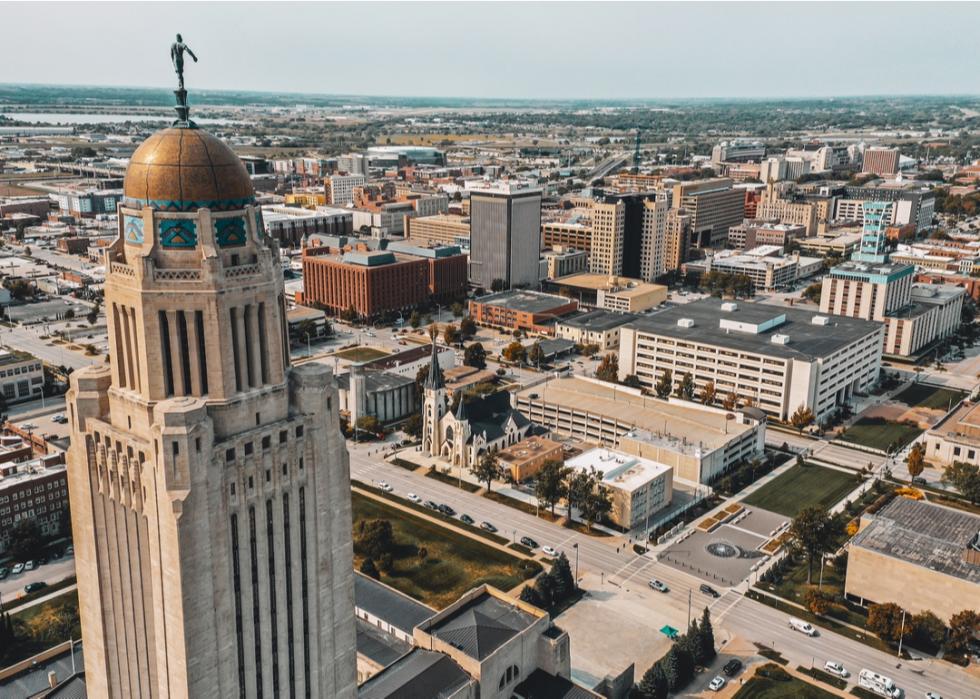
#40. Nebraska
- Index score: 33.7
- Unemployment rate in April 2021: 2.8% (5.5% less than in April 2020)
- House Price Index score in Q1 of 2021: 318.2 (10.4% greater than in 2020)
- Jobs existing in April 2021: 1,007,400 (7.5% greater than in April 2020)
- Real GDP in Q4 of 2020: $133.1 billion (current dollars, 11.2% greater than in Q2 of 2020)
Interestingly, at least one aspect of Nebraska’s economy thrived during the coronavirus: agriculture. Farming revenue rose by 37% in 2020, and it’s expected to continue rising over the next few years. And in non-farming related news, some lawmakers are considering increasing the maximum lifetime credit for microbusinesses—businesses with five or fewer full-time employees—in the wake of the coronavirus. In fact, 86% of businesses in the state, or 145,000 of them, are microbusinesses.

#39. Illinois
- Index score: 35.7
- Unemployment rate in April 2021: 7.1% (9.3% less than in April 2020)
- House Price Index score in Q1 of 2021: 229.9 (9.2% greater than in 2020)
- Jobs existing in April 2021: 5,727,000 (7.7% greater than in April 2020)
- Real GDP in Q4 of 2020: $886.6 billion (current dollars, 9.8% greater than in Q2 of 2020)
A lot of people moved out of Illinois during 2020. The Prairie State ranked as the third state with the most people leaving during the year, faring just slighter better than #2 New Jersey and #1 New York, based on a study from United Van Lines—66% of vans were leaving Illinois with only 34% coming into the state. This is actually an uptick from 2019, however, when Illinois ranked #2 as the state with the most people moving out of it. The other Midwestern states tend to have a more even split of people moving in and out.

#37. Missouri (tie)
- Index score: 37.2
- Unemployment rate in April 2021: 4.1% (5.6% less than in April 2020)
- House Price Index score in Q1 of 2021: 288.5 (10.4% greater than in 2020)
- Jobs existing in April 2021: 2,815,000 (9.6% greater than in April 2020)
- Real GDP in Q4 of 2020: $331.6 billion (current dollars, 10.8% greater than in Q2 of 2020)
The Kansas City COVID-19 Relief Loan Fund was announced in March of 2020. Set up by AltCap, the $5 million relief fund provides relief to small businesses. To meet eligibility, businesses had to be based in one of these counties: Platte, Clay, Jackson, Cass, Wyandotte, Leavenworth, or Johnson. Businesses in the arts, hospitality, food service, and retail, among others, are prioritized. Additionally, they have to have no more than 20 employees or exceed $2.5 million in yearly revenue.

#37. Kansas (tie)
- Index score: 37.1
- Unemployment rate in April 2021: 3.5% (7.7% less than in April 2020)
- House Price Index score in Q1 of 2021: 293.7 (10.2% greater than in 2020)
- Jobs existing in April 2021: 1,372,400 (8% greater than in April 2020)
- Real GDP in Q4 of 2020: $178.3 billion (current dollars, 10.5% greater than in Q2 of 2020)
In June 2021, Gov. Laura Kelly announced the members of a bipartisan committee that will be overseeing how the federal CARES Act funds will be distributed. Called the Strengthening People and and Revitalizing Kansas Taskforce, it will determine where the $1 billion in CARES Act funding will be allocated. The members are: House Speaker Ron Ryckman, Lt. Governor David Toland, Senate President Ty Masterson, as well as appointees Greg Orman, Bill Pickert, Jon Rolph, and Secretary of Administration DeAngela Burns-Wallace.

#36. Connecticut
- Index score: 38.6
- Unemployment rate in April 2021: 8.1% (0.2% greater than in April 2020)
- House Price Index score in Q1 of 2021: 209.3 (15.2% greater than in 2020)
- Jobs existing in April 2021: 1,580,600 (12.6% greater than in April 2020)
- Real GDP in Q4 of 2020: $288.9 billion (current dollars, 10% greater than in Q2 of 2020)
During March 2020, 300,000 jobs were lost in the state. As of March 2021, 58% of those jobs have come back, a figure that hasn’t changed all too much since September 2020. However, workers who made an income of $60,000 or more were able to recover jobs lost more easily than those whose salaries were less than $60,000. For those earning less, the unemployment rate was down by 28% as of February 2021.

#35. Hawaii
- Index score: 38.8
- Unemployment rate in April 2021: 8.5% (13.8% less than in April 2020)
- House Price Index score in Q1 of 2021: 287.8 (4.8% greater than in 2020)
- Jobs existing in April 2021: 562,100 (10.3% greater than in April 2020)
- Real GDP in Q4 of 2020: $90.8 billion (current dollars, 8.8% greater than in Q2 of 2020)
As of May 2021, Hawaii is experiencing a surge in visitors from the U.S. mainland, many of whom are probably seeking a beach vacation. As more and more Americans are travelling in general, coupled with increased rates of vaccination, travel and tourism to Hawaii are not expected to slow down. The University of Hawaii Economic Research Organization anticipates that travel to Hawaii will surpass pre-pandemic levels by a whopping 70% by the end of the summer 2021. However, even though demand for tourism is rising, Hawaii is falling short in terms of hiring, likely due to health and safety concerns and many residents leaving the state due to the coronavirus.

#34. Colorado
- Index score: 39.3
- Unemployment rate in April 2021: 6.4% (4.9% less than in April 2020)
- House Price Index score in Q1 of 2021: 560.4 (13% greater than in 2020)
- Jobs existing in April 2021: 2,690,900 (10.1% greater than in April 2020)
- Real GDP in Q4 of 2020: $401.1 billion (current dollars, 9.9% greater than in Q2 of 2020)
Colorado hasn’t fully recovered economically, but all signs point to a full recovery by 2022. The state is expected to add 90,000 jobs in 2021, and may reach “a new employment peak in 2022.” In part, this could be because 44,740 new business entities filed initial documents during the first quarter of 2021, a 29.2% growth. Optimism is also building from the growing rate of statewide vaccinations as well as the easing of business restrictions, similar to many other states.

#32. California (tie)
- Index score: 40
- Unemployment rate in April 2021: 8.3% (7.2% less than in April 2020)
- House Price Index score in Q1 of 2021: 342.2 (13.1% greater than in 2020)
- Jobs existing in April 2021: 16,248,200 (8.7% greater than in April 2020)
- Real GDP in Q4 of 2020: $3.2 trillion (current dollars, 9.4% greater than in Q2 of 2020)
There are a few factors that are aiding California’s recovery, as of June 2021. For one, the state had put in place strict health and safety precautions, which included waiting until June 15 to fully reopen—with proof of vaccination needed for large indoor events, robust distance learning, and strict mask mandates. But the state also benefits from being home to a host of highly skilled technology jobs, as well as experiencing a housing boom. However, jobs in the tourist sectors are lagging behind in June 2021.

#32. Texas (tie)
- Index score: 40
- Unemployment rate in April 2021: 6.7% (6.1% less than in April 2020)
- House Price Index score in Q1 of 2021: 342.1 (10.6% greater than in 2020)
- Jobs existing in April 2021: 12,524,500 (8.7% greater than in April 2020)
- Real GDP in Q4 of 2020: $1.8 trillion (current dollars, 11.8% greater than in Q2 of 2020)
Like in many other state economies, the unemployment rate in Texas often depends on the county, with more rural areas tending to be hit the hardest. The unemployment rate is the highest in South Texas, where many work in the oil fields. However, there are some promising trends, even in the areas hardest hit. Southern counties such as Hidalgo, Starr, Cameron and Willacy had employment rates that were trending upward in April 2021 compared to the previous month.

#31. New York
- Index score: 40.2
- Unemployment rate in April 2021: 8.2% (6.3% less than in April 2020)
- House Price Index score in Q1 of 2021: 292.4 (10.9% greater than in 2020)
- Jobs existing in April 2021: 8,882,200 (13.1% greater than in April 2020)
- Real GDP in Q4 of 2020: $1.7 trillion (current dollars, 8.6% greater than in Q2 of 2020)
New York City was once the epicenter of the coronavirus. It is recovering, albeit slowly. In April 2020, New York lost 1.9 jobs in the private sector. And in February 2021, the city had 1 million fewer jobs than it did in February 2020. Plus, jobs lost in the service industry—with some that may never come back—and the decline in tourism has further hindered recovery.

#30. Florida
- Index score: 40.5
- Unemployment rate in April 2021: 4.8% (8.1% less than in April 2020)
- House Price Index score in Q1 of 2021: 376.6 (11.1% greater than in 2020)
- Jobs existing in April 2021: 8,568,900 (9.8% greater than in April 2020)
- Real GDP in Q4 of 2020: $1.1 trillion (current dollars, 9.5% greater than in Q2 of 2020)
Florida is benefiting from a strong wave of people moving from states like New York and New Jersey to the Sunshine State. As of May 2021, around 900 people are moving to Florida each day. In part, this could be due to lower income taxes than states like New York, as well as part of strong migratory patterns to Southern and Southwestern states. However, Florida has been steadily attracting new residents long before the coronavirus. The population grew by 2.7 million between 2010 and 2020, which is double the rate of population growth in America.

#28. Alaska (tie)
- Index score: 40.8
- Unemployment rate in April 2021: 6.7% (6.2% less than in April 2020)
- House Price Index score in Q1 of 2021: 295.6 (8.2% greater than in 2020)
- Jobs existing in April 2021: 306,900 (7.9% greater than in April 2020)
- Real GDP in Q4 of 2020: $52.1 billion (current dollars, 14.1% greater than in Q2 of 2020)
Alaska was ahead of the curve in terms of lifting age requirements for COVID-19 vaccines. As of March 2021, Alaska announced that anyone 16 and older was eligible for the vaccine. As of June 20, 2021, 41.7% of Alaskans are fully vaccinated. While the usual cruise tourism has yet to pick back up, other tourist-related industries are experiencing the pleasant surprise of a busier-than-expected summer season, as visitors from the lower 48 seek out the state's majestic nature after a year in quarantine.
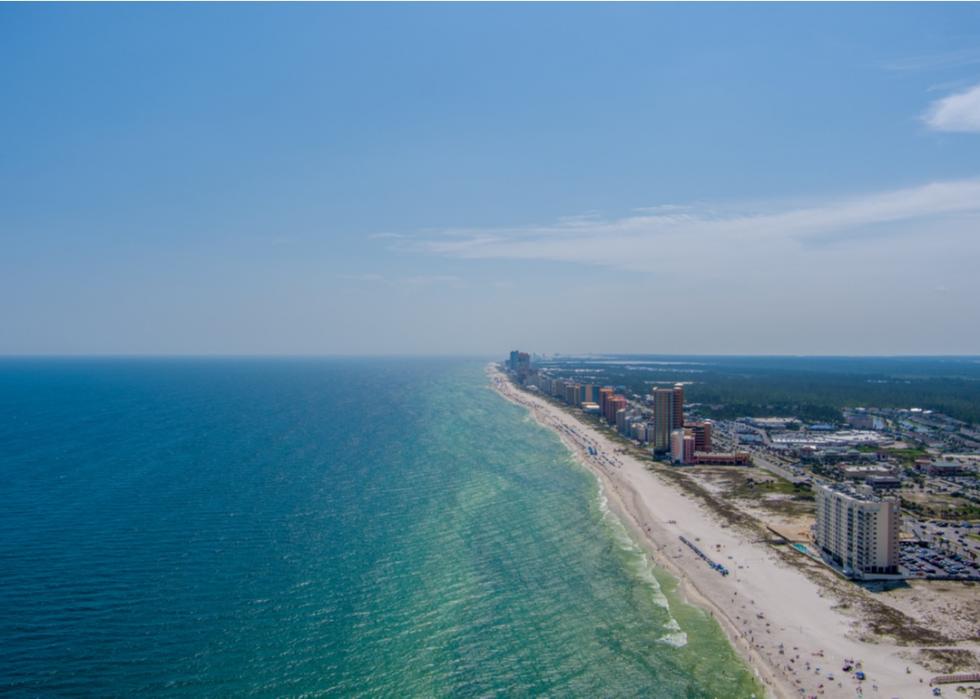
#28. Alabama (tie)
- Index score: 40.8
- Unemployment rate in April 2021: 3.6% (9.3% less than in April 2020)
- House Price Index score in Q1 of 2021: 266.7 (9.1% greater than in 2020)
- Jobs existing in April 2021: 2,011,100 (9.3% greater than in April 2020)
- Real GDP in Q4 of 2020: $231.7 billion (current dollars, 10.4% greater than in Q2 of 2020)
In June 2021, Gov. Kay Ivey allocated $2.6 million to six state counties, including Clarke, Houston, Lee, and Pike counties. These funds are to be spent on recovery efforts. All of these counties, plus Etowah, also received CARES Act funding from the federal government. In terms of the breakdown of the funding from the governor, Lee County, for example, received $500,000 to go toward food distribution and rental assistance; Coffee County will construct an emergency operations center with the $500,000 it received; and Pike County will buy additional ambulances for its fire department with the $400,000 Gov. Ivey provided.

#27. Arizona
- Index score: 41.9
- Unemployment rate in April 2021: 6.7% (5.9% less than in April 2020)
- House Price Index score in Q1 of 2021: 416.4 (14.7% greater than in 2020)
- Jobs existing in April 2021: 2,898,300 (8.9% greater than in April 2020)
- Real GDP in Q4 of 2020: $383.9 billion (current dollars, 9.7% greater than in Q2 of 2020)
Areas in Southern Arizona were hit especially hard during the coronavirus, largely due to their dependence on tourism. In 2020, around 295,000 jobs were lost in the region, which equates to a 10% decrease. Tucson saw a loss of revenue when the Tucson Gem Show—a convention for the selling of intricate gems, minerals, and fossils that’s typically held each year—was canceled in 2020 and again in 2021. The show alone typically equates to $30 million in spending per year.

#26. South Carolina
- Index score: 42.2
- Unemployment rate in April 2021: 5% (7.1% less than in April 2020)
- House Price Index score in Q1 of 2021: 293.6 (9% greater than in 2020)
- Jobs existing in April 2021: 2,113,300 (11.9% greater than in April 2020)
- Real GDP in Q4 of 2020: $248.8 billion (current dollars, 10.7% greater than in Q2 of 2020)
Republican Gov. Henry McMaster has been criticized for his handling of South Carolina’s response to the coronavirus. The governor, for example, never enforced a statewide mask mandate or placed a moratorium on foreclosures and evictions. However, the governor’s focus on the business climate of the state has meant that many South Carolina businesses were able to reopen more quickly than other states that had more safety precautions in place and were able to avoid some budget cuts. As of April 2021, there could be a surplus in the following year’s budget, with $550 million potentially saved up in case of future economic fallout.

#25. Georgia
- Index score: 42.8
- Unemployment rate in April 2021: 4.3% (7.6% less than in April 2020)
- House Price Index score in Q1 of 2021: 296.2 (11.9% greater than in 2020)
- Jobs existing in April 2021: 4,473,600 (10.3% greater than in April 2020)
- Real GDP in Q4 of 2020: $637.2 billion (current dollars, 9.7% greater than in Q2 of 2020)
Homes are selling pretty fast in Georgia, as of 2021. This is especially true in Atlanta, where the average home is selling for $390,000, which is up 17% where it was in 2020. And the Atlanta housing market was already doing well in 2020. Atlanta homes are experiencing a growth rate of 6.7%, above the national growth rate of 5.7%.

#23. Delaware (tie)
- Index score: 43.2
- Unemployment rate in April 2021: 6.4% (7.9% less than in April 2020)
- House Price Index score in Q1 of 2021: 251 (12.6% greater than in 2020)
- Jobs existing in April 2021: 444,300 (11.3% greater than in April 2020)
- Real GDP in Q4 of 2020: $77.7 billion (current dollars, 8.5% greater than in Q2 of 2020)
Delaware’s economic recovery has been helped—and is expected to continue being aided in the future—by a projected budget surplus. At the start of the coronavirus, Delaware had a budget surplus, which it exhausted fighting the pandemic in 2020. This meant that the state didn’t have to raise taxes. As of February 2021, another projected budget surplus of $495 million is thought to provide an extra budget cushion for the rest of 2021 and through 2022.
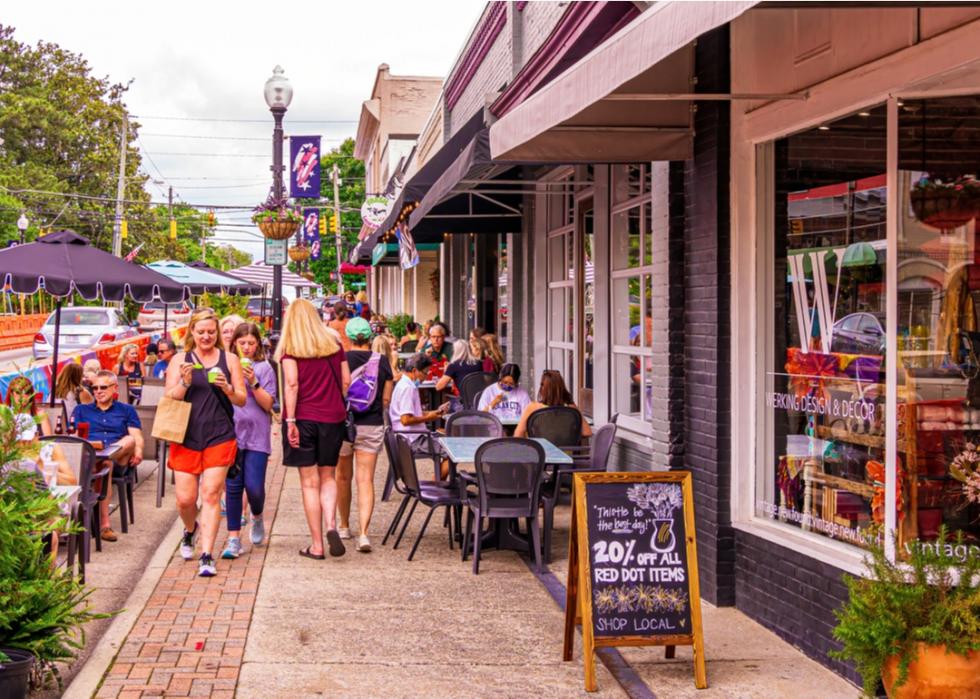
#23. North Carolina (tie)
- Index score: 43.2
- Unemployment rate in April 2021: 5% (7.2% less than in April 2020)
- House Price Index score in Q1 of 2021: 298.3 (11.8% greater than in 2020)
- Jobs existing in April 2021: 4,459,800 (10.1% greater than in April 2020)
- Real GDP in Q4 of 2020: $603 billion (current dollars, 10.3% greater than in Q2 of 2020)
In April 2021, Gov. Roy Cooper announced the Community Economic Recovery and Resiliency Initiative, an initiative that’s expected to help local North Carolina communities recover economically. The plan aims to support small businesses in the area while also providing guidance on how they can grow for the future. It will also zero in on asset mapping of local infrastructure and reviewing commercial district regulation. Additionally, North Carolina’s recovery has likely been aided by its strong population growth, which accelerated during the pandemic and has been steadily growing. As a result of the latest Census, the state received its 14th seat in Congress.

#21. Oregon (tie)
- Index score: 44.1
- Unemployment rate in April 2021: 6% (8.2% less than in April 2020)
- House Price Index score in Q1 of 2021: 522.2 (13% greater than in 2020)
- Jobs existing in April 2021: 1,842,300 (9.2% greater than in April 2020)
- Real GDP in Q4 of 2020: $256.5 billion (current dollars, 9.7% greater than in Q2 of 2020)
Gov. Kate Brown announced the 10-Point Recovery Plan in March 2021 in an effort to help local businesses and communities in Oregon, in particular communities of color, affected by the coronavirus. The plan will address recovery efforts and “existing disparities that were exacerbated by the pandemic.” In addition to the devastation caused by the coronavirus, 4,000 homes were lost due to wildfires that burned near Mount Hood in July 2020.

#21. Mississippi (tie)
- Index score: 44.1
- Unemployment rate in April 2021: 6.2% (9.2% less than in April 2020)
- House Price Index score in Q1 of 2021: 236.6 (7.1% greater than in 2020)
- Jobs existing in April 2021: 1,121,300 (10.8% greater than in April 2020)
- Real GDP in Q4 of 2020: $118.1 billion (current dollars, 11.8% greater than in Q2 of 2020)
Mississippi did not fare as poorly as many other states, however some sectors were hit quite hard. Economic output declined by 2.8% in 2020, but the arts, dining, hospitality and entertainment industries suffered serious damages—at a 20.2% loss—as might be expected. On the flip side, the utilities industry grew by 13.4%.

#20. Maine
- Index score: 47.1
- Unemployment rate in April 2021: 4.8% (5.8% less than in April 2020)
- House Price Index score in Q1 of 2021: 317.2 (13.2% greater than in 2020)
- Jobs existing in April 2021: 610,800 (12% greater than in April 2020)
- Real GDP in Q4 of 2020: $67.8 billion (current dollars, 10.3% greater than in Q2 of 2020)
Gov. Janet Mills revealed the Maine Jobs & Recovery Plan in May 2021. Part of the plan will focus on spending $150 million improving residents’ access to the internet, a broadband expansion that is likely to be crucial as more and more jobs are becoming remote. Additionally, $105 million will be directed toward education and child care programs. To help decrease the cost of health insurance for their workers, $39 million will go to small businesses.

#19. Wisconsin
- Index score: 47.4
- Unemployment rate in April 2021: 3.9% (10.2% less than in April 2020)
- House Price Index score in Q1 of 2021: 314.2 (9.5% greater than in 2020)
- Jobs existing in April 2021: 2,857,300 (10.3% greater than in April 2020)
- Real GDP in Q4 of 2020: $348.2 billion (current dollars, 10.9% greater than in Q2 of 2020)
As Wisconsin public health professionals were still working tirelessly to get shots in arms to health care workers, people over 65, and assisted living workers and residents in January and February of 2021, the eligibility guidelines offered vaccines to small and lesser-discussed Wisconsin communities: mink farmers. COVID-19 outbreaks at mink farms, which have been documented in Wisconsin and Utah as well as in Denmark, could pose a serious health risk. This is because COVID-19 spreads from farmers to the animals, who not only could become seriously sick themselves, but they could also spread disease to other wildlife populations. And potentially, minks could also infect people.

#18. South Dakota
- Index score: 47.8
- Unemployment rate in April 2021: 2.8% (7.4% less than in April 2020)
- House Price Index score in Q1 of 2021: 361.2 (11.7% greater than in 2020)
- Jobs existing in April 2021: 435,600 (9.3% greater than in April 2020)
- Real GDP in Q4 of 2020: $57.1 billion (current dollars, 12.2% greater than in Q2 of 2020)
South Dakota did not implement stringent health and safety precautions like stay-at-home orders and mask mandates. It managed to keep the unemployment rate relatively low and the economy fairly steady, even though tourism did decline. However, despite low population density and coupled with the relative lack of safety precautions, the state experienced the eighth highest death toll in the country, based on per capita population, as of March 2021.

#17. Washington
- Index score: 48.1
- Unemployment rate in April 2021: 5.5% (9.9% less than in April 2020)
- House Price Index score in Q1 of 2021: 466 (13.9% greater than in 2020)
- Jobs existing in April 2021: 3,343,200 (7.8% greater than in April 2020)
- Real GDP in Q4 of 2020: $638 billion (current dollars, 10.1% greater than in Q2 of 2020)
Some sectors appear to be growing in Washington in 2021, including information technology and e-commerce, at levels higher than the U.S. at large. And construction in the state is at pre-pandemic levels. Manufacturing, however, has been the hardest hit due to a decline in aerospace engineering.
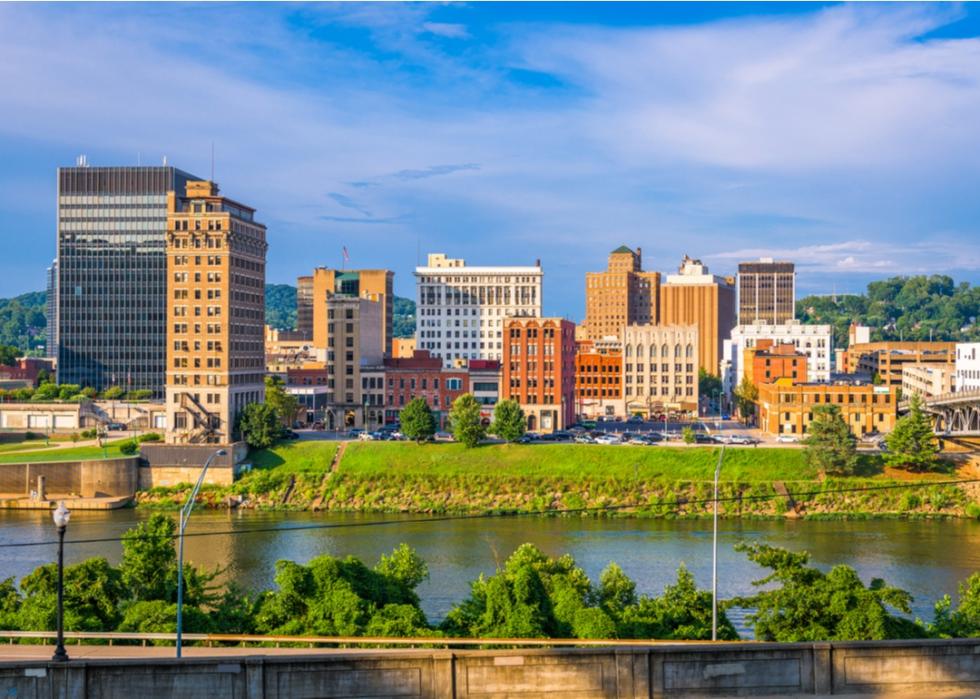
#16. West Virginia
- Index score: 49.3
- Unemployment rate in April 2021: 5.8% (9.4% less than in April 2020)
- House Price Index score in Q1 of 2021: 246.1 (9.4% greater than in 2020)
- Jobs existing in April 2021: 685,300 (10.9% greater than in April 2020)
- Real GDP in Q4 of 2020: $76 billion (current dollars, 11.7% greater than in Q2 of 2020)
West Virginia lost 94,000 jobs as a result of the coronavirus. The state is slowly getting those jobs back, but West Virginians won’t be seeing a full recovery just yet. The economy gained 57,000 of those lost jobs, but the remaining 37,000 might not return until the end of 2021. Unsurprisingly, dining and leisure were hard hit, as was the state’s coal mining industry, which experienced a sharp decline in demand—much more than other power sources. The coal mining industry is expected to experience a decline in demand until 2025.

#15. New Jersey
- Index score: 49.7
- Unemployment rate in April 2021: 7.5% (7.8% less than in April 2020)
- House Price Index score in Q1 of 2021: 287.4 (12.8% greater than in 2020)
- Jobs existing in April 2021: 3,900,800 (11.1% greater than in April 2020)
- Real GDP in Q4 of 2020: $634.9 billion (current dollars, 10.6% greater than in Q2 of 2020)
The New Jersey Recovery Act of 2020 may be able to revitalize the local economy in the years following the coronavirus. It will focus on tax incentives that are anticipated to draw in new development projects. In northern New Jersey, $715 million is expected to go toward innovative building projects, and $385 million is slated to be allocated to southern New Jersey communities. Many of these programs can last until 2027, potentially galvanizing opportunities for more local jobs to be created in New Jersey for the next several years.

#14. Massachusetts
- Index score: 51
- Unemployment rate in April 2021: 6.5% (8.6% less than in April 2020)
- House Price Index score in Q1 of 2021: 347.7 (12.4% greater than in 2020)
- Jobs existing in April 2021: 3,433,800 (12.9% greater than in April 2020)
- Real GDP in Q4 of 2020: $598.6 billion (current dollars, 9.5% greater than in Q2 of 2020)
Gov. Charlie Baker and Lt. Gov. Karyn Polito announced a plan to use around $2.815 billion of Massachusetts’ federal aid money. The plan, as of June 2021, is set to focus on prioritizing communities that have been hit the hardest by the pandemic. In this plan, $300 million will be directed toward supporting home ownership and $200 million is set to go toward helping close the wealth gap for communities of color in areas of the state that have been disproportionately affected by the coronavirus by promoting first-time home ownership. In addition, $240 million will go toward job training programs, and $50 million will support hospitals in areas that have been disproportionately affected by the coronavirus.

#13. Pennsylvania
- Index score: 51.9
- Unemployment rate in April 2021: 7.4% (7.7% less than in April 2020)
- House Price Index score in Q1 of 2021: 270.4 (11.1% greater than in 2020)
- Jobs existing in April 2021: 5,666,500 (14.2% greater than in April 2020)
- Real GDP in Q4 of 2020: $799.4 billion (current dollars, 10.4% greater than in Q2 of 2020)
The Pennsylvanian economy is doing better than expected. The state’s deficit, as of April 2021, hovers around $5 billion. However, the next round of relief aid is thought to be around $7.3 billion. So, with the extra funds perhaps lies opportunity. Gov. Tom Wolf has a few potential ideas. One is to replace the gas tax, which goes toward paying for construction and transportation, and replacing that tax with a driver’s mileage fee. The governor also has considered raising the taxes of the state’s highest income earners.

#12. Kentucky
- Index score: 54.3
- Unemployment rate in April 2021: 4.7% (10.7% less than in April 2020)
- House Price Index score in Q1 of 2021: 284.6 (9.5% greater than in 2020)
- Jobs existing in April 2021: 1,858,900 (11.8% greater than in April 2020)
- Real GDP in Q4 of 2020: $216.5 billion (current dollars, 11.7% greater than in Q2 of 2020)
Kentucky is poised to end 2021 on a strong note economically. Gov. Andy Beshear’s team has announced that the state is expected to close 2021 with a general fund surplus of $586 million. The governor said the surplus means that the state should have a “rainy day fund” of more than $1 billion, “the most money ever in a rainy day fund in Kentucky.” In terms of spending, school construction, improving broadband, and projects related to clean-water are three major project goals for the state.

#11. Ohio
- Index score: 58.6
- Unemployment rate in April 2021: 4.7% (12.1% less than in April 2020)
- House Price Index score in Q1 of 2021: 248.8 (10.8% greater than in 2020)
- Jobs existing in April 2021: 5,308,300 (12.4% greater than in April 2020)
- Real GDP in Q4 of 2020: $694.1 billion (current dollars, 10.8% greater than in Q2 of 2020)
Ohio has demonstrated an interest in supporting STEM education during the pandemic. The Choose Ohio First scholarship supports 3,400 students who are new to the program, as well as the 3,000 scholars that are already a part of the program. The scholarship is supported by 57 universities and colleges throughout Ohio, and could be a way of expanding Ohio’s workforce in STEM fields. Throughout the next five years, $69,826,882 will be awarded in scholarship money.

#10. Utah
- Index score: 59
- Unemployment rate in April 2021: 2.8% (6.9% less than in April 2020)
- House Price Index score in Q1 of 2021: 550.5 (17.7% greater than in 2020)
- Jobs existing in April 2021: 1,590,700 (11.1% greater than in April 2020)
- Real GDP in Q4 of 2020: $202.8 billion (current dollars, 10.9% greater than in Q2 of 2020)
Utah had a few things going for it that set the state up for relative economic success in terms of facing the pandemic. For one, it had a strong economy before the pandemic struck, and it also benefited from federal relief money. However, one thing that sets Utah apart from every other state—with the exception of Washington D.C.—is its residents’ adaptation to remote work. Nearly half of all Utah homes have at least one person who has been telecommuting during the coronavirus.
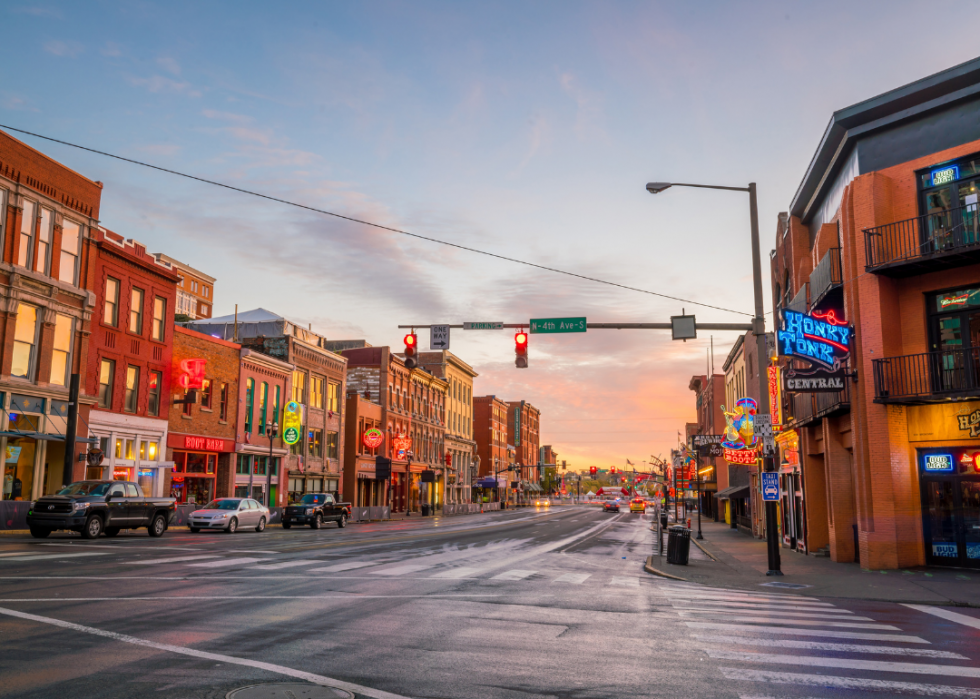
#9. Tennessee
- Index score: 59
- Unemployment rate in April 2021: 5% (9.7% less than in April 2020)
- House Price Index score in Q1 of 2021: 330.4 (12.4% greater than in 2020)
- Jobs existing in April 2021: 3,061,300 (10.4% greater than in April 2020)
- Real GDP in Q4 of 2020: $376.2 billion (current dollars, 12.9% greater than in Q2 of 2020)
Tennessee topped U-Haul’s list as the state where the most people moved to during 2020. The state showed growth before 2020, however the pandemic accelerated the trend, especially as more and more people are looking to live in the South and Southwest, and in smaller cities. The housing market in cities like Nashville and Knoxville, for example, are seeing extraordinary housing booms. Migration to Tennessee is likely to continue in the years ahead, especially because the state was already on an upward trend before the pandemic.

#8. Montana
- Index score: 62.1
- Unemployment rate in April 2021: 3.7% (7.6% less than in April 2020)
- House Price Index score in Q1 of 2021: 506.2 (16.3% greater than in 2020)
- Jobs existing in April 2021: 480,600 (12.9% greater than in April 2020)
- Real GDP in Q4 of 2020: $53 billion (current dollars, 11.1% greater than in Q2 of 2020)
Some regions of Montana were more negatively affected by the health and economic crises caused by the coronavirus than other regions. More rural areas are faring better than more densely populated ones, particularly because there was less virus spread and also because these areas depended a lot less on tourism and travel. Flathead Valley, for example, a highly populated part of the state, had an unemployment rate higher than elsewhere in the state—16% versus 11% statewide. In regions like Butte-Silver Bow, retail decreased by 7.8%, and the food and hotel industries there declined by 14.2%. The housing market in that region, however, is trending upward, especially with the rise of remote work.

#7. Indiana
- Index score: 67.9
- Unemployment rate in April 2021: 3.9% (13% less than in April 2020)
- House Price Index score in Q1 of 2021: 261.4 (11.2% greater than in 2020)
- Jobs existing in April 2021: 3,027,900 (13.6% greater than in April 2020)
- Real GDP in Q4 of 2020: $385.3 billion (current dollars, 12% greater than in Q2 of 2020)
Manufacturing has done well in Indiana during the pandemic, particularly due to the state’s fairly central location. But not all industries have fared as well. Leisure and transportation have lagged behind. However, spending in the state is expected to rise by 3% from 2022 to 2023. Employment levels are also predicted to return to pre-pandemic levels by 2022.

#6. Vermont
- Index score: 71.6
- Unemployment rate in April 2021: 2.9% (12.7% less than in April 2020)
- House Price Index score in Q1 of 2021: 280.6 (11.2% greater than in 2020)
- Jobs existing in April 2021: 291,400 (16.1% greater than in April 2020)
- Real GDP in Q4 of 2020: $33.7 billion (current dollars, 11.7% greater than in Q2 of 2020)
The coronavirus has impacted one of Vermont’s biggest industries: skiing. Around 4 million skiers head to Vermont mountains and slopes each year, with around 75% of skiers typically being from out-of-state. The ski resorts have sustained $100 million in losses throughout the pandemic. However, these businesses have also received $5.3 million in funding so far, which will recoup at least a small portion of the losses.
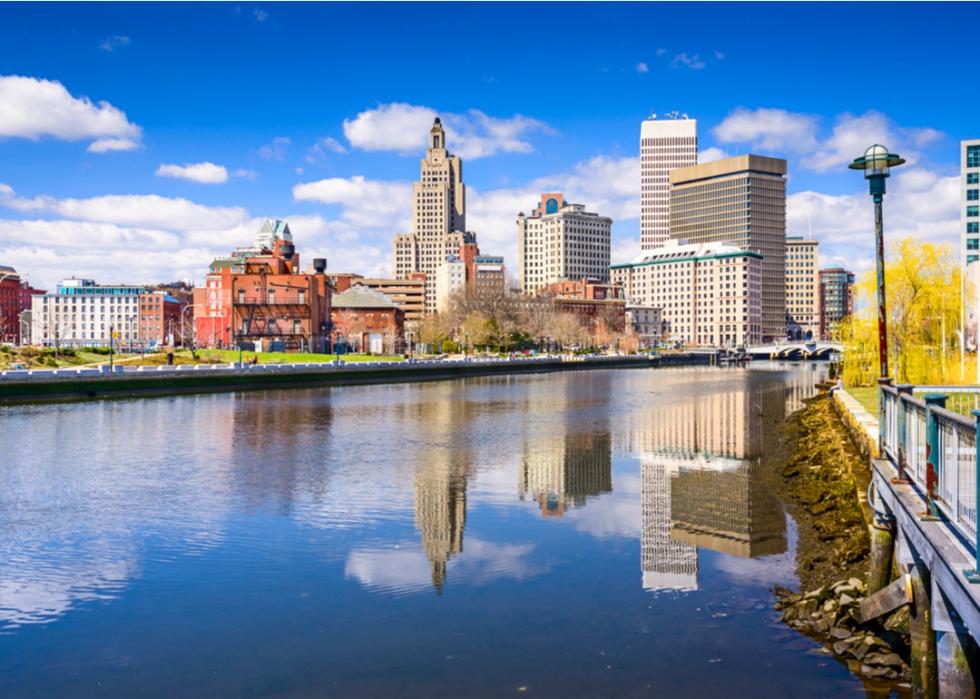
#5. Rhode Island
- Index score: 72.2
- Unemployment rate in April 2021: 6.3% (10.7% less than in April 2020)
- House Price Index score in Q1 of 2021: 290.4 (16.1% greater than in 2020)
- Jobs existing in April 2021: 467,600 (17.1% greater than in April 2020)
- Real GDP in Q4 of 2020: $61.6 billion (current dollars, 9.4% greater than in Q2 of 2020)
Economically, Rhode Island is a state that depends in large part on its tourism and retail markets, industries that have been particularly hard hit by the pandemic. Troublingly, the number of Rhode Islanders employed dropped to the lowest it’s been in 20 years—540,918. Several organizations—the Providence Foundation, the City of Providence, the Downtown Improvement District, and the Providence Warwick Convention & Visitors Bureau—have set up programs to help strengthen the local retail and hospitality industries.

#4. New Hampshire
- Index score: 74.8
- Unemployment rate in April 2021: 2.8% (13.5% less than in April 2020)
- House Price Index score in Q1 of 2021: 317.3 (14.1% greater than in 2020)
- Jobs existing in April 2021: 659,100 (15.1% greater than in April 2020)
- Real GDP in Q4 of 2020: $87.3 billion (current dollars, 10.9% greater than in Q2 of 2020)
By the time that the coronavirus hit New Hampshire, another epidemic was also raging: opioid addiction, and substance abuse more generally. In 2019, New Hampshire had the ninth highest rate of opioid deaths in the country. Also troublingly, people struggling with substance abuse are at a heightened risk of both contracting COVID-19 as well as having worse health outcomes if contracted. By the seventh month into the pandemic, seven recovery houses shuttered, which further strained resources for those struggling with addiction in the state. Although, these businesses did eventually receive CARES Act funding that helped them reopen.
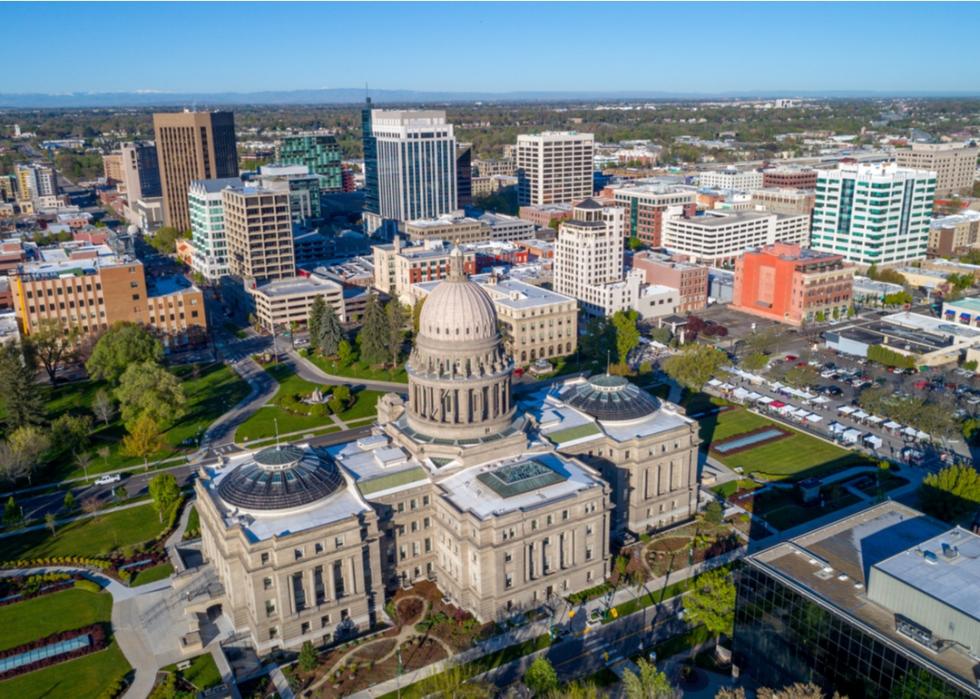
#3. Idaho
- Index score: 81.1
- Unemployment rate in April 2021: 3.1% (8.4% less than in April 2020)
- House Price Index score in Q1 of 2021: 481.3 (21.5% greater than in 2020)
- Jobs existing in April 2021: 784,900 (13.1% greater than in April 2020)
- Real GDP in Q4 of 2020: $87.4 billion (current dollars, 12.9% greater than in Q2 of 2020)
Idaho has not only seen jobs recover to pre-pandemic levels, but it has actually seen the employment rate surpass what it was before the pandemic. There are a couple reasons why. There’s low unemployment, for example, and lots of open space plus a growing construction sector and housing boom. However, as with many other states, there are disparities in terms of the workers most affected by unemployment in Idaho, with those who are making less than $16 per hour having to face more unemployment than those whose wages exceed that threshold.

#2. Michigan
- Index score: 92.7
- Unemployment rate in April 2021: 4.9% (17.8% less than in April 2020)
- House Price Index score in Q1 of 2021: 277.7 (11.6% greater than in 2020)
- Jobs existing in April 2021: 4,114,400 (21.1% greater than in April 2020)
- Real GDP in Q4 of 2020: $528.2 billion (current dollars, 11.1% greater than in Q2 of 2020)
Gov. Gretchen Whitmer outlined a series of initiatives in January 2021 aimed at helping the Michigan economy recover. For example, some residents and businesses will be set to benefit from the Business Accelerator and Resiliency Initiative, which will offer grants to tech start-ups; the Michigan Mainstreet Initiative, which will provide grants to small restaurants and businesses; and the Michigan Microenterprise Support Initiative, which is designed to help businesses with less than nine employees. And the COVID Recovery Plan will permanently expand unemployment benefits to 26 weeks rather than 20 weeks. Plus, with support from Good Jobs for Michigan, Pfizer built a drug manufacturing plant in Portage, Michigan, from where the company shipped the first doses of their COVID-19 vaccine.

#1. Nevada
- Index score: 100
- Unemployment rate in April 2021: 8% (20.2% less than in April 2020)
- House Price Index score in Q1 of 2021: 314.8 (11.5% greater than in 2020)
- Jobs existing in April 2021: 1,308,600 (17.6% greater than in April 2020)
- Real GDP in Q4 of 2020: $178.4 billion (current dollars, 14.1% greater than in Q2 of 2020)
There was some good news during a Nevada economic forum in April 2021: The state’s two-year revenue was predicted to be $586.2 million above what that same forum had predicted in December 2020. Gov. Steve Sisolak attributed much of Nevada’s recovery to the state’s high vaccination rate, which showed that 46% of people 16 or older have had at least one jab of a COVID-19 vaccine—and in June 2021, Sisolak announced a $5 million cash prize for a lucky vaccinated Nevada resident. The governor plans to allocate some of the surplus revenue toward fixing the Nevada Department of Employment, Training and Rehabilitation, which has been experiencing some issues in terms of unemployment payments during the pandemic.



